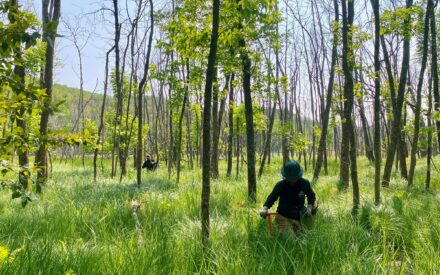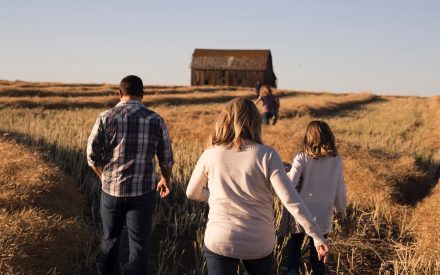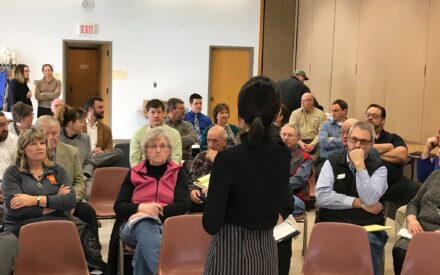It has been estimated that each acre of Wisconsin cropland is losing approximately 4.5 tons per acre per year of soil to erosion. At the current soil erosion rate, we are losing the thickness of a dime of soil per year. Over 20 years, that equates to about an inch of topsoil lost. It is estimated that it would take 500-1000 years to rebuild this one inch soil loss through natural processes, which would be near impossible in agricultural production, even with the most stringent conservation practices.
Though the impact of soil loss on agricultural productivity varies based on soil type, depth and climate factors, research shows that thinner topsoils (A horizon) are correlated with reduced yield and resiliency to extreme weather conditions. In addition to loss of agricultural productivity, soil loss and nutrient loss have dire environmental impacts. Many production practices commonly used in agriculture such as tillage, single season cropping, and monocultures further exacerbate this issue.
The Mississippi River/Gulf of Mexico Hypoxia Task Force (EPA) maintains that the “continued implementation of cost-effective, voluntary, incentive-based best management practices and conservation practices at the local and regional level” is a crucial water quality priority needed to meet the goal of reducing nitrogen and phosphorous loads in the Mississippi River Basin by 45%, a goal set by the task force in 2008. The Wisconsin Nutrient Reduction Strategy works together with the priorities of the Mississippi River/Gulf of Mexico Hypoxia Task Force (EPA), and UW-Madison Extension is a critical partner in accomplishing said goals in partnership with producer- led watershed councils (DATCP) and local or county governments.
“[Extension] is currently leading a manure nutrient credit study on our farm which is identifying the soil fertility value of our manure and reducing the amount of purchased fertilizer.”
Lafayette Ag Stewardship Alliance farmer talks about on-farm soil health research
On-Farm Soil Health Research
In response to Wisconsin’s soil health degradation, Extension engages farmers in trialing and implementing innovative practices that are aligned with integrated research. There are several research activities Extension supports regarding soil degradation.
One on-farm research project studied the use of living aisles and no-till planting strips to mitigate the impacts of intense rain events. A pilot research project studied the effect of copper sulfate footbath application on soil and alfalfa copper concentrations via manure spread. Additional research was done to better understand which species of mycorrhizal fungi grow in association with cranberries and other ericoid species to improve plants’ uptake of nutrients from the soil to more effectively, environmentally and economically, increase cranberry yields. Another project researched vegetable pathogens to improve crop health and reduce chemical inputs and soil disturbance.
Applying Research to Outreach
To ensure research findings are disseminated to the farmers who need and use them, Extension engages farmers in a variety of outreach activities. In 2022, Extension provided 127 consultations to farmers and farm groups through phone, email, and in-person visits to discuss topics of crop management, pasture management, soil health, and soil sampling. Written products included seven research-based articles, newsletters, and fact sheets on topics including cover crop termination, soil and water conservation, and conservation tillage. A webinar series—offered biweekly during the spring, summer, and fall—provided information and research findings to farmers and industry professionals about implementing new soil health building practices, protecting Wisconsin’s natural resources, and improving the profitability of farms across the state.
In-person activities included nine field days or pasture walks and a variety of workshops, trainings, and conferences across the state. Field days and pasture walks engaged farmers in on-the-ground implementation of innovative practices including summer annual cover crop species, reduced tillage, planting green extended crop rotation, managed grazing, managing carbon and nitrogen ratios in cover crops, cover crop impact on water infiltration rates, and disease management in cover crop systems. Workshops and trainings reached 12,288 farmers and industry professionals and covered topics like soil health principles, pasture management, bale grazing, alternative fertility, cover crops, manure, soil conservation, erosion mitigation, nitrate leaching in waterways, soil and water infiltration, and nutrient management.
With the overarching goal of improving soil health and water quality while ensuring long-term profitability of farms, Extension has helped farmers increase their understandings of the impact of cover cropping, tillage, and innovative management practices. Farmers learned specific skills like the mechanics of interseeding; fall, winter, and spring management and termination of cover crops; techniques to minimize tillage; nitrogen and phosphorous management in their cropping systems; and more. Through post-event evaluations, farmers reported Extension programming improved their knowledge around cover crop decision making and anticipated devoting additional acres to cover crops.
Download Article

 Protecting the St. Louis River Estuary
Protecting the St. Louis River Estuary Improving Farms through Informed Decision-making
Improving Farms through Informed Decision-making Strengthening and Engaging Local Health Coalitions
Strengthening and Engaging Local Health Coalitions More Effective, Efficient Government
More Effective, Efficient Government


